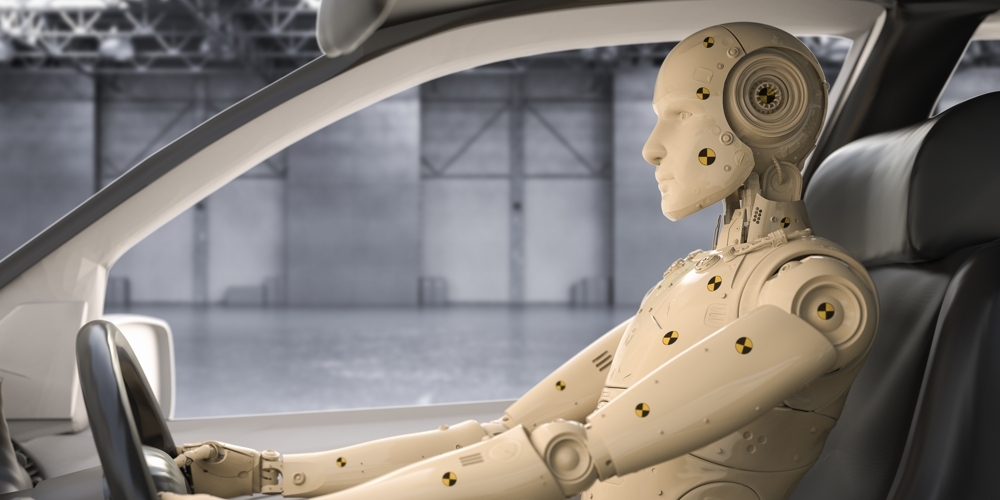
Just as there is a routine for moving off and changing gear, there is also a routine for stopping.
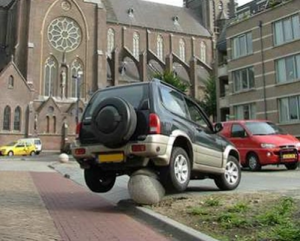 The method for stopping is the same as for moving off - it's the routine that will be at the heart of almost everything you do when you're driving
The method for stopping is the same as for moving off - it's the routine that will be at the heart of almost everything you do when you're driving
The 'Mirrors, Signal Manoeuvre' routine (MSM)
On this page, we explain the importance of the MSM routine when stopping and parking.
Apart from stopping safely, you will also need to stop legally, and if you are parking, leave the car in a safe position.
It's difficult to know whether the vehicle shown in the picture is parked legally or not; after all, it seems to be in a car park (but only just!). However, I don't know what you think, but the DriverActive verdict is 'could do better!'
Stopping on the left will usually be the best and safest option; in most places, parking on the left will be the only legal option at night (Highway Code Rule 248).
Sometimes, you will have to stop on the right, you might have no other choice; this could be because it's the only available space, or you might be making a delivery, or have an elderly or infirm passenger who needs to be as close to their destination as possible.
While stopping and parking on the left is the preferred option, the DVSA recognises that there are legitimate reasons for stopping on the right - this is why there is a driving test exercise to test your ability to do it safely.
The Driving Test Success app has a full set of videos covering stopping and moving off in all situations that you might encounter on your driving test and in everyday driving - Driving Test Success. Google Play | App Store - (appstore practical videos available as an in app purchase in the 4 in 1 kit)
There will be some natural stops in traffic during your driving test, and you will also need to stop before specific test manoeuvres so that the examiner can explain what they want you to do. Your driving test examiner will also ask you to stop at other times during the test, including a stop on the right-hand side of the road.
The examiner might ask you to stop and then move off again for no apparent reason. However, the examiner could be checking things like where you choose to stop, how you stop, or how you move away after stopping. Your job is simply to stop and move away safely every time.
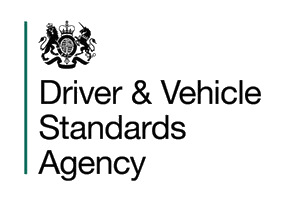 Whenever you stop, the examiner will consider:
Whenever you stop, the examiner will consider:
Your use of mirrors and signals
How smoothly you use the controls
Your choice of stopping/parking position
The examiner's instruction to stop at the side of the road will be:
"Pull up on the left at a convenient place, please."
alternatively, the examiner might ask you to stop in a specific place:
"Pull up along here, just before .... please", "Pull up next to the .... please", "Pull up on the right-hand side, please."
The Mirrors Signal Manoeuvre (MSM) routine is essential for safe driving. You have already started to learn about this in the Moving Off lesson.
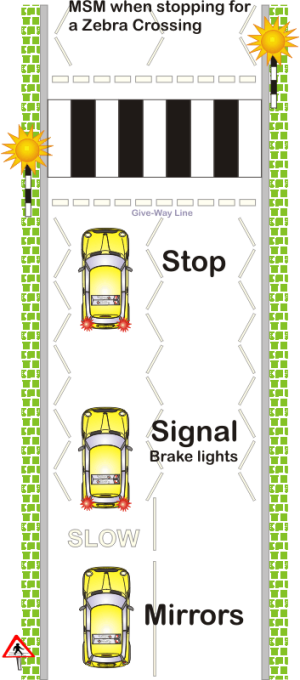 When moving off, you make observation checks as part of the POM routine and then decide whether to give a signal; when you do this, you are using the Mirrors, Signal, Manoeuvre routine (MSM).
When moving off, you make observation checks as part of the POM routine and then decide whether to give a signal; when you do this, you are using the Mirrors, Signal, Manoeuvre routine (MSM).
You will learn more about the routine as your course develops; however, it's helpful to understand the basics to help you with moving off and stopping.
The information below applies equally to situations where you pull up on the left to drop off passengers or park and make normal stops in traffic, for example, in a traffic queue or at a red light.
The reason for checking your mirrors before you do anything else is simple; you are asking yourself the following question:
"Is it safe to complete my intended manoeuvre?"
Here, 'Manoeuvre' refers to any driving action, starting, stopping, turning, speeding up, slowing down; anything that means your vehicle will be changing speed or direction.
Suppose you plan to do something, for example, to slow down and turn left at a junction, but you see something in your mirrors that might make it unsafe, perhaps an emergency or out of control vehicle. In that case, the answer to the "Is it safe to complete my manoeuvre" question will be a firm "No".
In reality, it's rare for plans to be changed because of vehicles behind, but if a problem arises, you will need to deal with it. The action you take will depend on the situation; in an extreme case, you might need to change your mind, aborting the manoeuvre and taking an alternative course of action. The fact that something could be happening behind to threaten your safety makes the mirror check absolutely essential.
When using your mirrors before stopping, you also have to consider how your manoeuvre will affect the drivers and riders behind.
For example, if someone is following too close behind, you might decide to stop a little further along the road - doing this would give the following driver more time to react to your actions.
Check your interior mirror and door mirrors to ensure that it is safe to stop.
Signals help or warn other road users.
When another road user, a driver, pedestrian, cyclist or whoever, might be affected by the action you intend to take, you will need to signal to let them know what's happening. When stopping and parking, your decision to signal will depend on what you see on the road ahead and in your mirrors.
If there is nobody who will benefit from a signal, then you don't need to give one.
The signals associated with stopping are the left turn indicator or arm signal and the brake lights. The brake lights automatically warn following drivers when you are slowing and stopping in traffic - in some situations, although rarely used in everyday driving - a slowing down arm signal can be helpful.
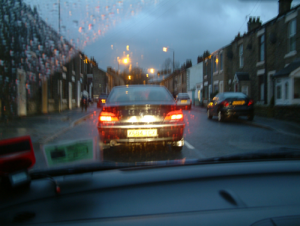
When stopping, as at all other times, you need to keep complete control of the car; this becomes even more important when stopping in poor weather conditions like those shown in the picture.
Manual:
To stop a manual car, you will use the footbrake and clutch.
Automatic:
In automatics, you simply apply progressive pressure to the brake pedal.
Electric:
In electric vehicles (EVs), you might be able to stop by doing nothing more than releasing the 'power pedal'.
Depending on the car and your skill as a driver, you might find that you can stop accurately in a predetermined place by simply releasing the 'power pedal' (accelerator/decelerator). This technique is called 'one pedal' driving
One pedal driving is possible because of the 'regenerative' function of the car's electric motor(s). The motor(s) generate electricity as the vehicle slows; this action slows the motor(s), which, in turn, slows the car. Even when you use the footbrake for normal stops, you will probably use it later in an EV than in a car with an internal combustion engine.
All cars:
After stopping, you will often need the handbrake to secure the car.
In vehicles with an engine stop/start system, the engine will automatically turn off to save fuel and help save the planet. If you stop for more than a few seconds, for example, at a red light, it's good to shift the gear lever/selector into neutral. In a manual, select first gear and release the handbrake to restart the engine. In an automatic, select Drive and release the handbrake.
In automatics and EVs using the handbrake means that you can take your foot off the footbrake while holding the car - this avoids dazzling the driver behind with your brake lights.
When teaching you about stopping and slowing down, your instructor will use the term 'Progressive Braking'.
Progressive braking refers to how you use the brake pedal or ease off the 'power' in an electric car.
Skilled braking control requires more than slamming your foot down on the pedal! Expert drivers 'eeeeze and squeeeeze' the pedals.
The amount of pressure you use on the brake pedal (or how much pressure you release on an electric car power pedal) will depend on how fast the car is moving and how soon you want to stop. As a general rule, the quicker you are going, the harder you press the brake or ease off the power pedal.
In manual and automatic cars, there are three 'phases' of progressive braking:
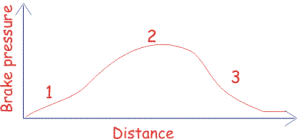
Take up the slack
Here, you press the brake pedal to 'feel' the brakes starting to 'bite'; this also switches on the brake lights to warn following drivers.
More pressure
Apply more pressure to lose most of your speed. The degree of pressure and how long you hold it will depend on your speed when you start braking.
Ease off
Ease the pressure on the brake pedal, sometimes releasing it completely; this will allow the car to 'roll' to a smooth stop. If you were to keep full pressure on the brake pedal, the vehicle would jerk forwards and skid in extreme cases.
You also have to press the clutch pedal down to prevent the engine from 'stalling' in a manual car. The clutch is used approximately one or two car lengths before the car stops. It's important not to press the clutch down too soon because this can affect your control of the car and reduce the effect of the brakes.
The process is the same in an electric car if using the footbrake. If you are driving in one pedal mode, the skill will be in how gently you can release the power pedal.
When your car has come to a complete stop, put on the handbrake and select neutral if you are parking or waiting in traffic. (Remember that handbrake and neutral allow you to release the brake pedal, preventing you from dazzling drivers behind your brake lights.)
Important: Wait until the car has stopped completely before applying the handbrake because you need your hands on the wheel to steer; pulling the handbrake on when the vehicle is moving can also cause a skid in some conditions, even at very low speeds.
All cars:
You must ensure that the handbrake is on before leaving the vehicle (legal requirement). You must also switch off your engine, headlights and fog lights.
Manual: You can leave the gear lever in neutral or in gear. If parked on a hill, leaving the car in 1st gear (facing uphill) or reverse (facing downhill) can assist the handbrake in preventing the vehicle from rolling down the hill.
Important environmental consideration: Rule 123 of the Highway Code states that if a vehicle is stationary and likely to remain so for more than a couple of minutes, you should switch off the engine to reduce emissions and noise pollution.
Automatic & Electric:
When parking in an automatic or electric car, apply the handbrake (legal) and select Park; if you are only stopping for a few minutes but remaining in the driving seat, using the handbrake and selecting neutral is good practice; in this situation.
See Highway Code Rule 239 for more information.

It can be tempting to look down at the kerb to see how close you are when stopping, but you will often hit it if you do this! Hitting the kerb can be very expensive because it wrecks your tyres and alloy wheels.
When driving normally, you need to look well ahead for accurate steering. You do the same thing when stopping.
Visualise the space you want to stop in, then aim for that space, looking well ahead to keep the car straight.
It can often help if you focus your attention on a car parked well ahead of you. It will also help to 'kill' your speed while on your driving line (your normal position on the road). Only steer in towards the kerb when your car is so slow that it has almost stopped - if you get this right, you will probably need to release some pressure from the brake pedal to go far enough forward to park in a straight line.
Watch the clip below to find out how to park neatly and straight.
You'll notice that the clip refers to 'confidence' - sometimes people are confident, but they lack judgment; after getting it wrong a few times, the confidence goes! The clip shows you how to develop your judgment and your confidence.
Choosing a safe parking place is vital for security and safety. You also want to park somewhere that's convenient.
It might be convenient to park on the footpath while you load the groceries into your car, but would it be convenient for someone on a mobility scooter or a mum with a buggy?
Whenever you stop, you should consider whether you may be causing inconvenience to others and that you park legally.
The diagram on the right shows what must be the worst parking street in Britain and highlights some of the places where you should avoid stopping and parking.

A = Opposite a junction
B = On the path or verge
C = On double yellow lines
D = Blocking a gateway
E = Too close to a junction
F = Too close to a junction
G = Opposite a Junction and on yellow lines!
The examples on the diagram show some poor parking choices, but they are not the only places where parking could cause problems or get you into trouble. Other places include:
Yellow lines at specified times
On school entrance markings
Bus stops
On bends
Near the brow of a hill
Double red lines (denoting a 'red route')
Clearways
Motorways
On the right-hand side at night (except on a one-way street)
You can find out more about waiting and parking by reading the section entitled 'Waiting and parking' in The Highway Code, where you will find a list of places to avoid when parking.
Also, when you read your Highway Code, you will discover that there are times when you can stop on some yellow lines legally and safely; however, if you get it wrong, you get a ticket!
 Stopping Quiz ...
Stopping Quiz ... Click here to complete the quiz for this lesson
(The page will open in a new window/tab)
You will find references for the answers in this lesson or The Highway Code.
You can check your answers as you go along, or complete the full quiz before checking.
Leaving the check to the end is a good way to test yourself.
When you check or review your answers you will get a brief explanation of the answer.
Good Luck!